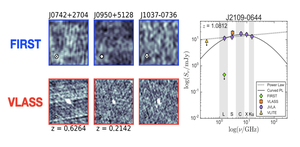Finding the Youngest Radio Jets
 The authors present new sub-arcsecond Jansky Very Large Array (VLA) imaging at 10 GHz of 155 ultra-luminous (Lbol∼1011.7−14.2L⊙) and heavily obscured quasars with redshifts z ∼ 0.4−3. The sample was selected to have extremely red mid-infrared to optical color ratios based on data from the Wide-Field Infrared Survey Explorer (WISE) along with a detection of bright, unresolved radio emission from the NRAO VLA Sky Survey (NVSS) or Faint Images of the Radio Sky at Twenty-Centimeters (FIRST) Survey. High-resolution VLA observations have revealed that the majority of the sources in this sample (93 of 155) are compact on angular scales < 0.2 arcseconds (≤ 1.7 kpc at z ∼ 2). The radio luminosities, linear extents, and lobe pressures of these sources are similar to young radio active galactic nuclei (AGN) but their space density is considerably lower. Application of a simple adiabatic lobe expansion model suggests relatively young dynamical ages (∼104−7 years), relatively high ambient interstellar medium densities (∼1−104 cm−3), and modest lobe expansion speeds (∼30−10,000 km s−1). The authors find their sources to be consistent with a population of newly-triggered, young jets caught in a unique evolutionary stage in which they still reside within the dense gas reservoirs of their hosts. Based on their radio luminosity function and dynamical ages, the authors estimate only ∼20% of classical large scale FRI/II radio galaxies could have evolved directly from these objects. They speculate that the WISE-NVSS sources might first become Gigahertz Peaked Spectrum or Compact Steep Spectrum sources, of which some might ultimately evolve into larger radio galaxies.
The authors present new sub-arcsecond Jansky Very Large Array (VLA) imaging at 10 GHz of 155 ultra-luminous (Lbol∼1011.7−14.2L⊙) and heavily obscured quasars with redshifts z ∼ 0.4−3. The sample was selected to have extremely red mid-infrared to optical color ratios based on data from the Wide-Field Infrared Survey Explorer (WISE) along with a detection of bright, unresolved radio emission from the NRAO VLA Sky Survey (NVSS) or Faint Images of the Radio Sky at Twenty-Centimeters (FIRST) Survey. High-resolution VLA observations have revealed that the majority of the sources in this sample (93 of 155) are compact on angular scales < 0.2 arcseconds (≤ 1.7 kpc at z ∼ 2). The radio luminosities, linear extents, and lobe pressures of these sources are similar to young radio active galactic nuclei (AGN) but their space density is considerably lower. Application of a simple adiabatic lobe expansion model suggests relatively young dynamical ages (∼104−7 years), relatively high ambient interstellar medium densities (∼1−104 cm−3), and modest lobe expansion speeds (∼30−10,000 km s−1). The authors find their sources to be consistent with a population of newly-triggered, young jets caught in a unique evolutionary stage in which they still reside within the dense gas reservoirs of their hosts. Based on their radio luminosity function and dynamical ages, the authors estimate only ∼20% of classical large scale FRI/II radio galaxies could have evolved directly from these objects. They speculate that the WISE-NVSS sources might first become Gigahertz Peaked Spectrum or Compact Steep Spectrum sources, of which some might ultimately evolve into larger radio galaxies.
Figure caption: [Left] VLA Sky Survey and FIRST images of the emerging radio loud quasar population. [Right] VLA spectrum of one source showing the flat radio spectrum.
Publication: Pallavi Patil (University of Virginia) et al., High-resolution VLA Imaging of Obscured Quasars: Young Radio Jets Caught in a Dense ISM, Astrophysical Journal, 896, 18 (9 June 2020).




Connect with NRAO